PACIFIC ALLIES LAUNCH OPERATION CARTWHEEL
SWPA HQ, Brisbane, Queensland, Australia • April 26, 1943
By January 1943, as the six-month campaign for Guadalcanal in the Southwest Pacific Solomon Islands was winding down (the Japanese abandoned the island on February 7), it became clear that the Allies lacked sufficient resources to swiftly dislodge the Japanese from heavily fortified Rabaul, 650 miles to the west. Rabaul, sitting on the northeastern end of New Britain Island, was Japan’s main forward operating base for naval and air units in the Southeastern Pacific, having fallen to an enemy invasion force of 20,000 men the previous January. Rabaul’s huge bay—actually the caldera of a volcano—accommodated dozens of large warships and auxiliary vessels. Ashore, Japanese construction workers eventually excavated 350 miles of tunnels and caves into the volcanic soil around the town and installed underground barracks, clinics, maintenance facilities, and ammunition dumps.
In recognition of these developments the Allies announced on this date, April 26, 1943, a slower, more deliberate plan for Rabaul’s capture, codenamed Operation Cartwheel. It superseded a plan by Gen. Douglas MacArthur, Supreme Commander of the Southwest Pacific Area, who had proposed immediately after the Japanese naval defeat at Midway (June 1942) a quick campaign against Rabaul that would result in the capture of that bastion in less than three weeks (!) and push Japan’s strongest advance base in the South Pacific over 800 miles northwards to Truk (Chuuk) in the Central Pacific. However, by the summer of 1943 the idea of “island hopping” (i.e., leapfrogging) past the Rabaul stronghold was floated, gaining strength at the end of the year when American soldiers and Marines landed on the opposite side of New Britain from Rabaul, at Cape Gloucester, and found themselves tied down not only by the Japanese enemy but by parasitic and viral diseases (malaria and dengue, typhoid, and yellow fevers), swamps, fungal infections (jungle rot), and jungles infested with leeches, fire ants, and giant mosquitoes.
Eventually the Allies abandoned Rabaul as an objective. They cut off and bypassed Japanese strongholds to attack more lightly defended islands. The criterion became not how many Japanese troops and armaments they could defeat or destroy, but how to obtain islands to use as aerial launching pads en route north to Japan with the least risk of casualties. That said, seizing Japanese-held islands in a series of amphibious assaults was rendered costly by the fanatical determination of the Japanese defenders. In the Marines’ campaign to capture Tarawa Atoll in the Central Pacific Gilbert Islands (November 20–23, 1943), out of a modest-size garrison of 3,000 enemy troops, 1,000 construction workers, and 1,200 Korean forced laborers, just 17 Japanese (one officer and 16 enlisted men) and 129 Koreans survived the battle. Adm. Chester Nimitz, commander in chief of the North, Central, and South Pacific theater areas, acknowledged the strategic importance of the U.S. victory at Tarawa. “The capture of Tarawa,” he stated, “knocked down the front door to the Japanese defenses in the Central Pacific.”
![]()
Battle of Tarawa in the Gilbert Islands, November 20–23, 1943
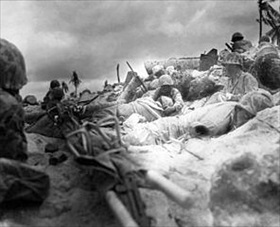 | 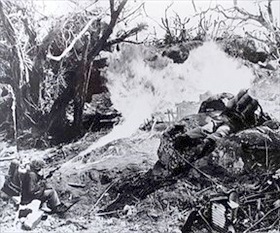 |
Left: U.S. Marines from the 2nd Marine Division seek cover among their dead and wounded behind the seawall on Red Beach 3, Betio Island in Tarawa Atoll, late November 1943. One out of five Marines who assaulted the beaches died. Half of Operation Galvanic, the Battle of Tarawa, coordinated with the bloody eastern phase of Operation Cartwheel, was the first American offensive in this critical Pacific region, and it was also the first time in the war that the U.S. faced serious Japanese opposition to an amphibious landing. One combat correspondent called Tarawa “the toughest battle in Marine Corps history.”
![]()
Right: The battle for Betio Island—an island half the size of New York’s Central Park—began to turn against the Japanese defenders around midafternoon on November 21, 1943. Supplies came ashore, Marine artillery added close fire support, and Marines moved off their beachheads as more Marines piled ashore. In this photo a Marine uses a flamethrower to clear a path through what was once thick jungle. Enemy soldiers were burned alive in their foxholes, bunkers, and caves or were picked off by rifle fire after first being set ablaze by flamethrowers in the savage fighting.
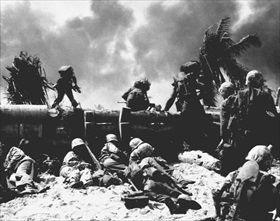 | 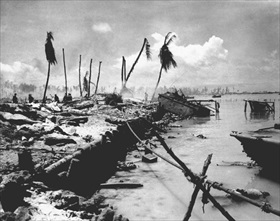 |
Left: Betio’s defenders deployed steel fortifications (tetrahedrons), minefields, and dense thickets of barbed wire. Walls of coconut logs and coral surrounded much of the island. Machine guns, rifle pits, and antitank ditches were often integrated into the barricades, and many emplacements such as pillboxes had converging fields of fire. Against the withering fire of numerous Japanese machine guns in pillboxes, bunkers, and dugouts, U.S. Marines climb over the coconut-log barricade to attack from their beachhead.
![]()
Right: This was the scene on Betio Island after the 2nd Marine Division forced back the Japanese on November 20–21, 1943. Many Marines had a hard time getting over the seawall on the beach. Dead bodies and wrecked amphibious tractors littered the battlefield. At the end of the first day, 5,000 men had made it across Betio’s coral reef, but 1,500 of them had fallen or were missing.
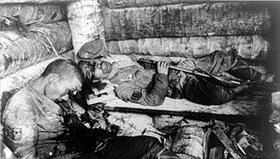 | 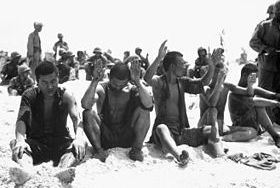 |
Left: Two marines of the Japanese navy’s Special Naval Landing Forces committed suicide in their dugout by shooting themselves rather than surrender to U.S. Marines. At Tarawa Americans faced one of the best, most concentrated Japanese defenses encountered in the Pacific War. The island’s 4,500 Japanese defenders—more than half of them first-rate troops—were well supplied and well prepared, and they fought almost to the last man, exacting a heavy toll on U.S. Marines (1,009 killed and 2,101 wounded) and sailors (687 killed). Nearly all the casualties occurred in the first 76 hours. Marines moved on to other islands in the atoll, meeting tenacious resistance. By November 28, however, the enemy, in the words of the commander of the 2nd Marine Division, had been “wiped out.” Those not wiped out, meaning Japanese POWs, totaled a mere 146.
![]()
Right: Marines guard Japanese POWs dressed in rags on a Tarawa beach, late November 1943. Many of the POWs were strip naked or to their loincloths to make sure that they had no hidden weapons.
With the Marines at Tarawa, U.S. Government Film (1944)
![]()

 History buffs, there is good news! The Daily Chronicles of World War II is now available as an ebook for $4.99 on Amazon.com. Containing a year’s worth of dated entries from this website, the ebook brings the story of this tumultuous era to life in a compelling, authoritative, and succinct manner. Featuring inventive navigation aids, the ebook enables readers to instantly move forward or backward by month and date to different dated entries. Simple and elegant! Click
History buffs, there is good news! The Daily Chronicles of World War II is now available as an ebook for $4.99 on Amazon.com. Containing a year’s worth of dated entries from this website, the ebook brings the story of this tumultuous era to life in a compelling, authoritative, and succinct manner. Featuring inventive navigation aids, the ebook enables readers to instantly move forward or backward by month and date to different dated entries. Simple and elegant! Click 











